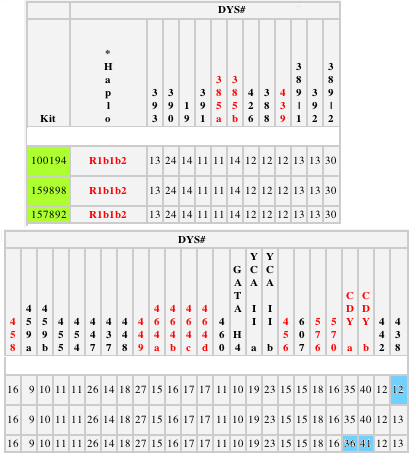Well, apparently I don’t know how to scrape the inside of my cheeks properly, since the lab took extra long to culture my Y-chromosome DNA. But I finally have a complete 37-marker Y-chromosome DNA test back, so now our Taylor family has three datapoints from which to triangulate a historical haplotype for our common ancestor, John3 Taylor (d. 1741). Here is the data from three test subjects, including me, in the tabular form published by familytreedna.com:

There are three boxes highlighted in blue, in which one value does not match the value for the others. 100194 differs from the others in the last locus, and 157892 differs from the others in two other loci (nos. 34 and 35 out of 37). Each disagreement between values represents a mutation somewhere in the family tree, but where? And where there is disagreement, which number is the ‘original’ one, belonging to the common ancestor? Having three test subjects with known places in the family tree permits a certain degree of confidence assessing the discrepancies. The chart I put into an earlier post showed the descent of the three test subjects from two sons of John Taylor (d. 1741). Here I include the same chart with the DNA test kit numbers below each of the subjects:

This shows us that subject nos. 159898 and 100194 both descend from Harrison4 Taylor (d. 1811), and subject 157892 descends from Harrison’s brother Simon4 Taylor (d. 1786); both of these are sons of John3 Taylor (d. 1741) who is the most recent common ancestor of all three subjects.
In the one locus (the last one, locus 37) where 159898 and 157892 agree while 100194 does not, we can be certain that the mutation must have happened somewhere between 100194 and his ancestor Septimus5 (son of Harrison4). With the other two disagreements, where 100194 and 159898 differ from 157892, we don’t know which line has the mutation. We can assume that every value shared by 100194 and 159898 belonged to their common ancestor Harrison4. Since 157892 has a different value, the mutation must lie somewhere between Harrison4 and 157892. There are nine possible individuals in whom each mutation might have occurred: Harrison4 himself, his brother Simon4, or any of the seven other men down the line from Simon4 to subject 157892. So there is a 1/9 (or 11%) chance that it was actually Harrison4 who had the mutation (and therefore the value borne by 157892 is the original); and an 8/9 (or 89%) chance that 157892 bears the mutated value, the mutation having occurred somewhere between Simon and 157892 himself. So in these two loci, 34 and 35, we aren’t yet certain which values were borne by the common ancestor, John3 Taylor; and we won’t know until other subjects are tested, ideally who descend from an earlier common ancestor. I have now contacted known descendants of John3 Taylor’s brother George3, who hopefully can contribute DNA to this project!

One Trackback/Pingback
[…] news! Following work begun in the summer and already blogged here, and here, we now have another matching DNA sample from another branch of our Taylor family, which […]
Post a Comment